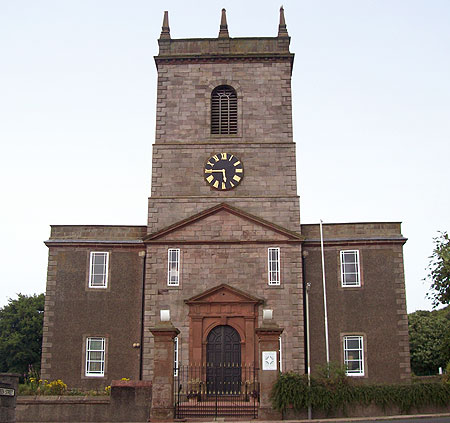
Queen Street is the longest street in Whitehaven and crosses Lowther Street at ninety degrees to form the other axis of the grid. At the lower end it has a dog leg to run parallel with Irish Street caused by the need to fit in with existing old town streets radiating from the harbour. The Queen in question was probably the Portuguese Catherine of Braganza who married Charles II. The street lies parallel to King Street. From the Market Place its runs across the middle of the town intersecting Lowther Street, passing the St. Nicholas church gardens, crossing Duke Street and George St. and continuing to St. James church at the top of the hill on High Street.

Before the building of St. James church, Queen Street as seen on the Bird's Eye View painting by Matthias Read, only went as far as the rope walk which ran along what is now George Street. Eventually terraced houses ran all the way up to High Street. These were 3 storeys high and close to the road but had become run down and gave a very dark dismal appearance. In the 1960's these were replaced by more modern flats which all lay at right angles to Queen Street leaving the only houses on upper Queen Street as St. James Court. This has given it a much greener and more expansive demeanour.
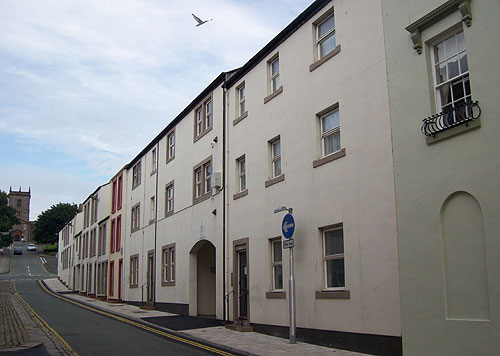
These new apartments between George Street and Duke Street replaced very old and dilapidated terraced houses that originally continued all the way up the hill. Many had lost roofs and internal floors had collapsed but these rebuilds have kept some of the character and retained the central courtyards which now provide essential space for off street parking for the residents. On this side of the road was once the house of James Hogarth a local philanthropist who donated his large mansion in 1783 to the Whitehaven Dispensary. This was a general medical facility for the town centre set up by Dr. Joshua Dixon which preceded the infirmary on Howgill Street and the later hospital. Previously, as can bee seen on Read's painting, this side was all gardens except for a house on the corner with Duke Street.
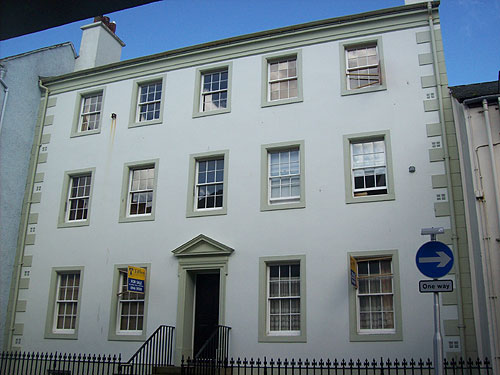
Across the road is this large Georgian style house with central entrance in simple classical style separated from the street by iron railings and steps. It gives an idea of the grandeur of some of the houses that were lost. As a large modern family would probably want a detached home with a garden rather than a town house, this has been split into separate apartments.
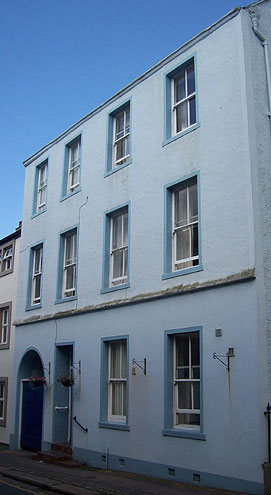
The house next door includes an archway to a rear courtyard but is otherwise much more plain and was built at an earlier date of about 1742 and owned by a merchant called John Lewthwaite. It would appear he also had a large warehouse attached to this side of the house.
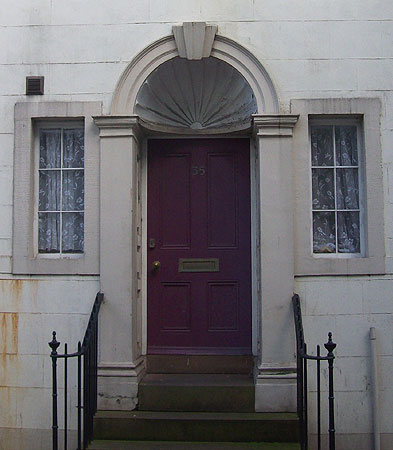
This doorway with its arched pediment with a shell like vault is the Queen Street entrance of a house that faces onto Duke Street. A pair of small windows flank the square columns to shed light onto a wide hallway that leads to the internal staircase. The house was built around 1760 and probably belonged to a watchmaker called Edward Steel.
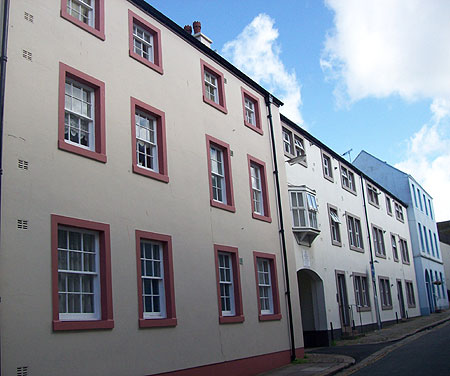
An extra piece of detail that adds interest to this street is the oriole window that hangs above the archway to the rear courtyard.
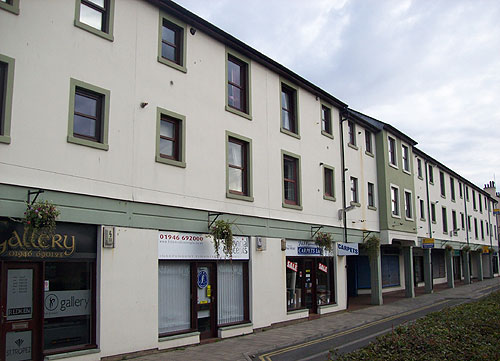
Between Duke Street and Lowther Street one side of the road is occupied by the St. Nicholas Gardens which form a centrepiece to the town and have helped win Whitehaven many Cumbria in Bloom awards. On the other side of the road we have a row of shops with apartments above. Though modern these are built with suitable proportions for the Georgian town centre and fit in extremely well. Those at the Lowther Street end have an arcade walkway which is a great idea for the occasionally inclement weather we experience but this is spoilt by the fact that it doesn't run the full length and that the shops are rather disjointed from the other shopping areas.
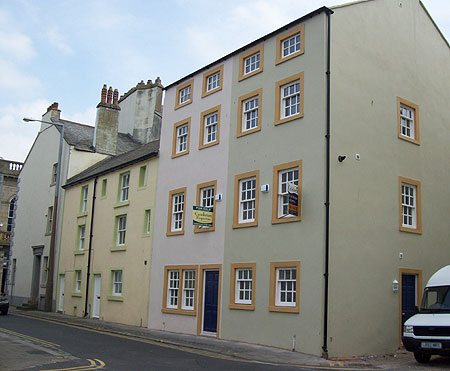
The first two houses have only just been built on Queen Street and occupy the site where for many years was a small antique shop. Again, done in a style which we'll have to start calling Whitehaven Georgian revival, they have a very tidy and smart appearance. One of them actually has its door on Fox Lane which adds an individual twist to the pair.
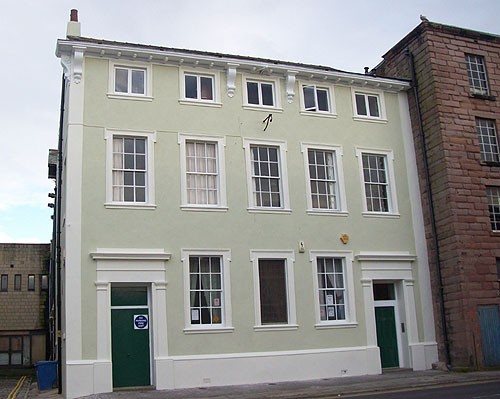
The first building after Fox lane was known as Wulstan Hall. The facade of this building was radically altered sometime around the beginning of the 20th century when an old photograph shows the same building with a single doorway. At this time, between 1888 and 1906, it was the Whitehaven Free Public Library. The paladian style doorway was in the centre where there is now a window and 5 steps led down to the pavement. Also there was a low wall running level with the front of the warehouse surmounted by head high iron railings that would have given some privacy when presumably this was originally a private mansion. For a time it was also the premises of the Mechanics' Institute where John Fletcher Miller once lectured.
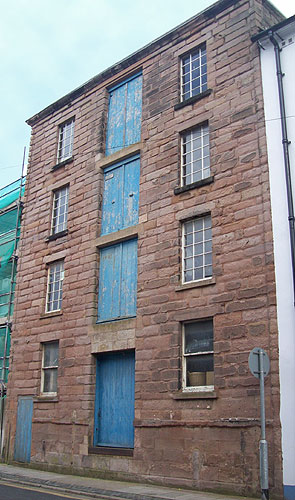
It is strange to find this large four storey warehouse sandwiched between William Brownrigg's grand town house and the Wulstan Hall. This gives an indication of the importance of trade in Whitehaven with warehouses not only around the harbour but throughout the town - quite often adjoining the fine houses of merchants to which they belonged. This was also the first premises of the West Cumberland Farmers which moved to what in later years became the Council Offices on Catherine Street.
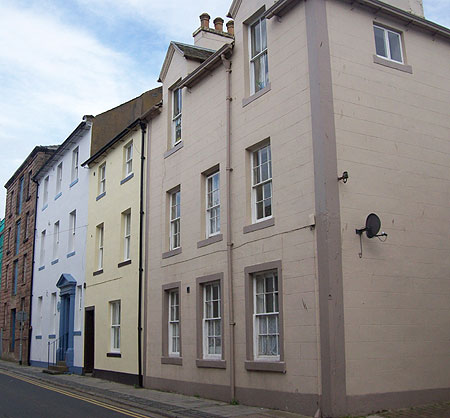
The first of the two houses after the warehouse, in blue and white, belonged to William Brownrigg, F.R.S. a local doctor, businessman, and nationally acclaimed scientist. He was resident here throughout most of his medical career but retired to his family home, Ormathwaite, near Keswick. The house on the corner like many in Whitehaven has the windows facing the main street with the entrance around the corner on the side street. This allowed for large well lit front rooms with a grand entrance hall behind but from the outside gives an awkward appearance of an isolated main doorway that is no longer the focal point of the main facade.
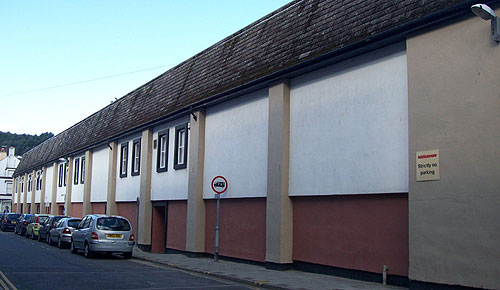
The opposite side of the street was originally lined with similar houses but these had fallen into such disrepair that the whole site was cleared and the Co-op decided to build a new superstore on the site. The idea on paper was that it would loosely resemble a row of houses on the outside but the compromises due to budget and function have left a rather awkward looking building. As they weren't allowed to build a car park the Co-op struggled to compete once permission was given to other large stores on the edge of town with adequate parking. Fortunately, Wilkinson's has moved in, selling a wide range of household goods and helping to maintain retail trade within the town centre.
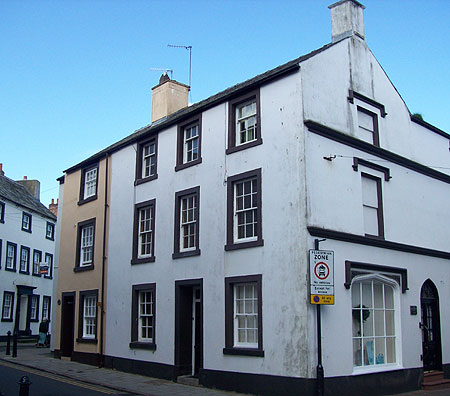
This house on the corner of Queen Street and Roper Street is unusual in that it is typically Whitehaven Georgian in style on the Queen Street side with windows symmetrically surrounding a central doorway but around the corner on Roper Street it morphs into a shop of the gothic revival style.
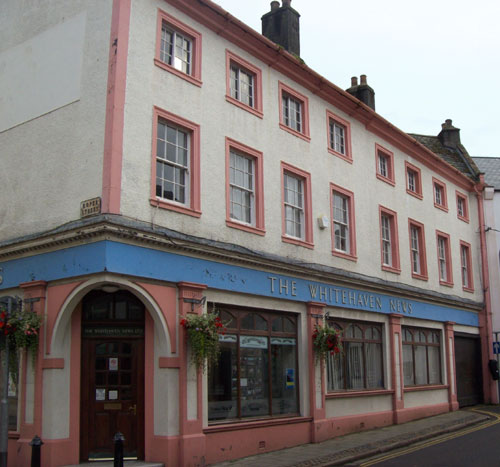
The Whitehaven News is the local weekly newspaper sold every Thursday. It was first published here by William Alsop as a monthly in 1852 and was printed in the Whitehaven until 1969 but it hasn't always been at this location. For three years after 1878 it was published on King Street by Robert Foster at the Cumberland Pacquet office. Since 1962 it has been owned by Cumberland Newspapers or the CN group but previously from 1881 it had been a private company. Originally occupying the Roper Street section, a Queen Street house and shop were purchased in 1923 and the whole facade remodelled with a corner entrance in 1927.
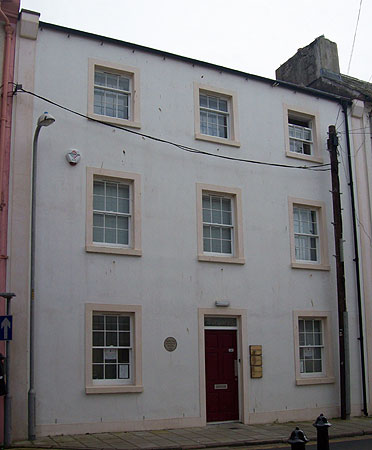
One could be forgiven for thinking Richard Benedict house, a doctors surgery, had been here since the 18th century. Actually, for many years it was a vacant lot marked by an old wooden garage door that lead to the back of the Irish Street car showroom. This new-build retains the character of the street but includes modern facilities such as an elevator for disabled access not available at the previous surgery on Irish Street.
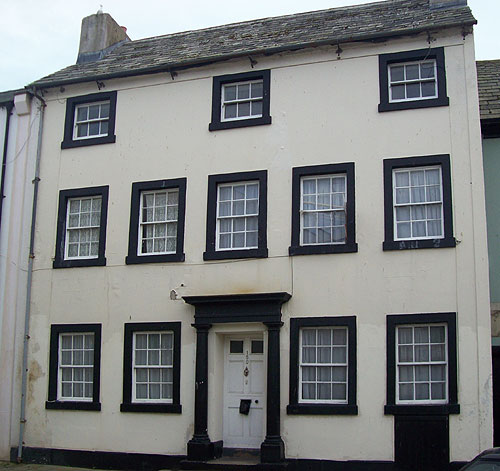
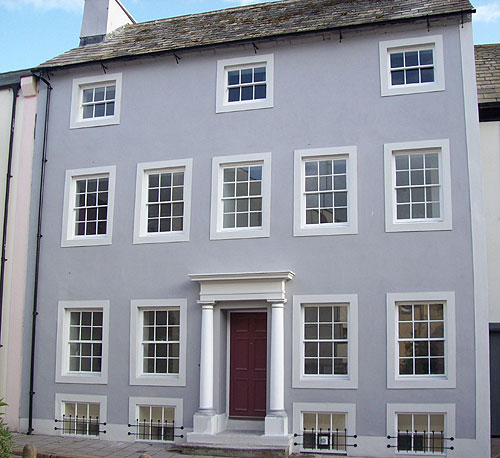
Another large 18th century town house on Queen Street with large central classical style doorway. Note that the upper windows on many Georgian houses are smaller having only 6 pains as opposed to 12 on the lower floors. This was partly because these were usually only servants rooms, partially housed in the roof but also, from the street level, it has a perspective effect of actually making the building look taller. The two photographs taken only months apart show how the town is constantly changing - not only has the paint changed to give a much brighter and more refined appearance but it has regained the basement windows that had been completely hidden.
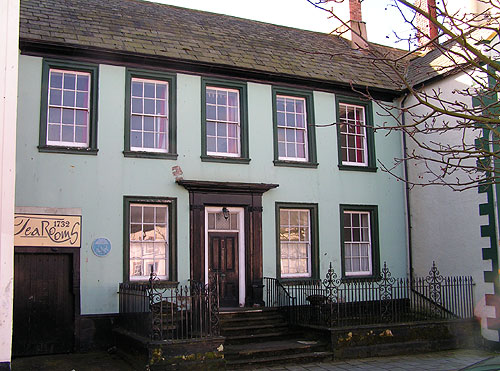
The next house was built about 1733 by William Gale who lived there until his death in 1774. The house is set back from the street with ornamental railings and a central steps leading up to an oversized door surround of classical style which is one of the earliest surviving in Whitehaven. To the left is an enclosed carriageway leading to rear stables. To the right and projecting onto the street is a separate wing that would have probably been a warehouse and is now a separate house. William Gale bought the land from Dr. John Heslop along with two gardens extending back onto Irish Street. The house has many features that have survived including wood panelling from floor to ceiling. William Gale was a merchant who traded with America and there is also a cellar with a barrel vaulted ceiling where goods such as tobacco and rum could have been stored. William's older brother George married Mildred Warner in Virginia and she was the grandmother of the first U.S.A. president, George Washington. It is fitting then that opposite the house is an open space named Washington Square which features a mural of a ship sailing from Whitehaven to America.
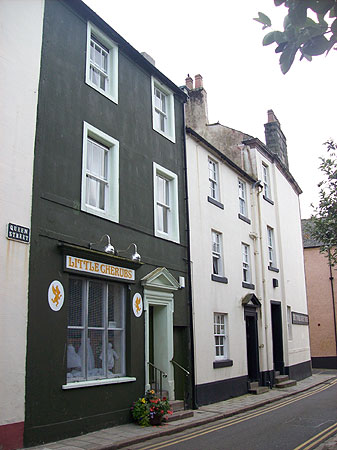
Keeping track of shops in Whitehaven is a task in itself. The quaint little shop tastefully situated in the ground floor of this town house, with its moderately sized shop window and avoidance of plastic or neon signage, was until recently Little Cherubs selling beautiful christening gowns and babywear.
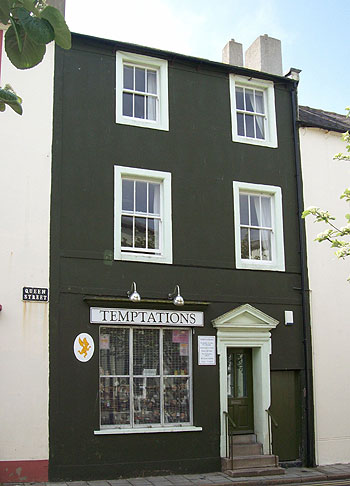
They have now moved their business to King Street and it has been taken over by Temptations selling all sorts of collectibles. This takes Queen Street to the corner of Cross Street and the Tivoli Guest house that has doors on both streets and was mercifully saved from dilapidation at the end of the 1960's, which removed houses beyond Cross Street on this side of the street.
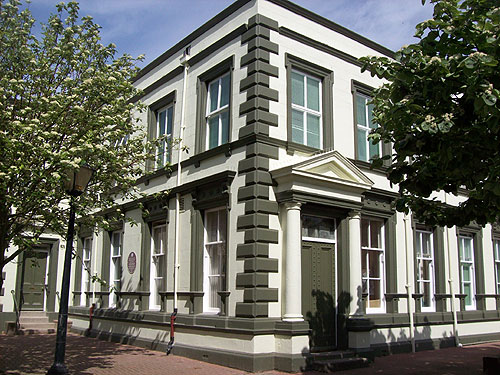
On the other side of the road is this old bank on the corner of Coates Lane and set at an angle to the rest of the street. It was originally ran by Messrs. Hartley and Co. and was in 1811 one of 3 principal banks in the town. This was also the birthplace in 1864 of Dame Edith Mary Brown , the pioneering educationalist, who set up a medical college for women in India.
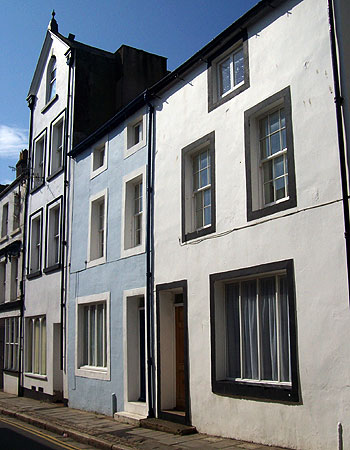
The following pair of buildings appear to have been converted to shops and then back to houses with their large ground floor windows. The next tall thin building unusually stands above the rest of the street with a fourth storey built into the street-facing gable end.
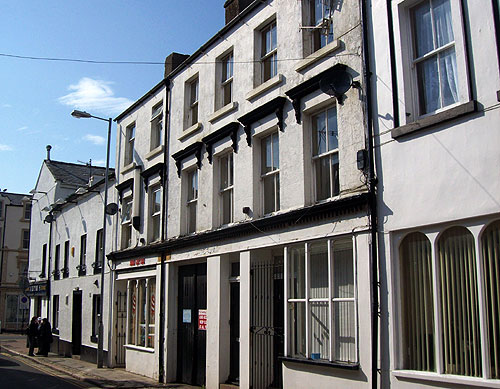
The remaining houses have shop fronts and there is also an entrance to a rear courtyard. Beyond this is a two storey extension to the Anchor Vaults public house. Before the formation of Queen Street this area was known as Tickell Lane.
© WAWL 2009